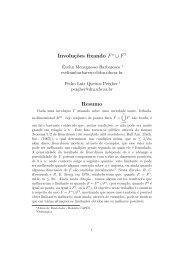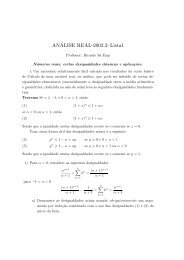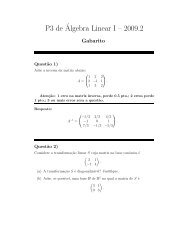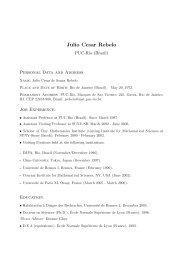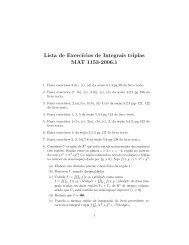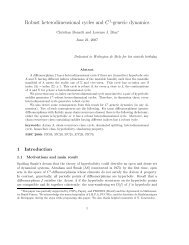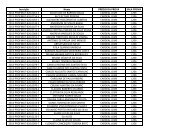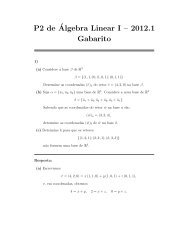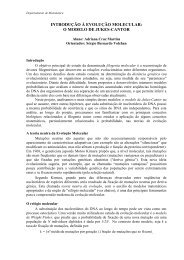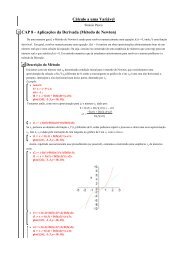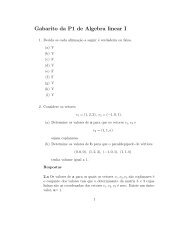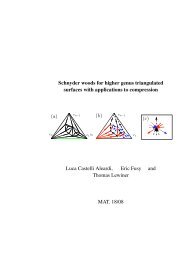Gpu octrees and optimized search Daniel Madeira, Esteban Clua ...
Gpu octrees and optimized search Daniel Madeira, Esteban Clua ...
Gpu octrees and optimized search Daniel Madeira, Esteban Clua ...
You also want an ePaper? Increase the reach of your titles
YUMPU automatically turns print PDFs into web optimized ePapers that Google loves.
<strong>Gpu</strong> <strong>octrees</strong> <strong>and</strong> <strong>optimized</strong> <strong>search</strong><br />
<strong>Daniel</strong> <strong>Madeira</strong>, <strong>Esteban</strong> <strong>Clua</strong>,<br />
Anselmo Montenegro <strong>and</strong> Thomas Lewiner<br />
MAT. 09/09
Cadastro de Pré–publicação : MAT. 09/09<br />
Título :<br />
<strong>Gpu</strong> <strong>octrees</strong> <strong>and</strong> <strong>optimized</strong> <strong>search</strong><br />
Autores : <strong>Daniel</strong> <strong>Madeira</strong>, <strong>Esteban</strong> <strong>Clua</strong>, Anselmo Montenegro <strong>and</strong><br />
Thomas Lewiner<br />
Palavras Chave : 1. Octree 2. GPU<br />
3. Geometric Search 4. Hardware Acceleration<br />
Número de páginas : 7<br />
Data de submissão : May 24 th , 2009<br />
Endereço eletrônico :<br />
http://www.mat.puc-rio.br/˜tomlew/octreecuda_sibgrapi.pdf<br />
Área de Concentração : □ Matemática Pura Matemática Aplicada<br />
Âmbito : □ Nacional Internacional<br />
Vínculado com a tese de : <strong>Daniel</strong> <strong>Madeira</strong>, orientada por <strong>Esteban</strong> <strong>Clua</strong><br />
Linha de Pesquisa do Artigo :<br />
Projeto de Pesquisa (conforme relatório CAPES) :<br />
Computação Gráfica<br />
Reconstrução de Objetos Geométricos<br />
Projeto de Pesquisa vinculado (orgão financiador) :<br />
. .<br />
Outras Informações Relevantes :<br />
. .<br />
. .<br />
Breve Descrição do Projeto (em case de projeto novo) :<br />
. .<br />
. .
<strong>Gpu</strong> <strong>octrees</strong> <strong>and</strong> <strong>optimized</strong> <strong>search</strong><br />
DANIEL MADEIRA 1 , ESTEBAN CLUA 1 , ANSELMO MONTENEGRO 1 AND THOMAS LEWINER 2<br />
1 Institute of Computation — Universidade Federal Fluminense —Niterói — Brazil<br />
2 Department of Matematics — Pontifícia Universidade Católica — Rio de Janeiro — Brazil<br />
www.ic.uff.br/˜{dmadeira,esteban,anselmo}. www.matmidia.mat.puc--rio.br/tomlew.<br />
Abstract. Octree structures are widely used in graphic applications to accelerate the computation of geometric<br />
proximity relations. With the increasing power of graphics hardware, processing tasks are progressively ported of to<br />
those architectures. However, <strong>octrees</strong> are essentially hierarchical structures, <strong>and</strong> octree <strong>search</strong>es mainly sequential<br />
processes, which is not suited for GPU implementation. On one side, several strategies have been proposed for<br />
GPU octree data structure, most of them use hierarchical <strong>search</strong>es. On the other side, recent works introduced<br />
<strong>optimized</strong> <strong>search</strong>es which avoid hierarchical traversals. In this work, we propose a GPU octree that allows for those<br />
<strong>optimized</strong> <strong>search</strong>es, which uses the GPU streaming to <strong>search</strong> for large of points at once. Moreover, we propose a<br />
parallelization of those <strong>optimized</strong> <strong>search</strong> to speed up the single point <strong>search</strong>. Finally, the proposed structure takes<br />
advantage of the recent graphics hardware architectures to improve the GPU octree data structure.<br />
Keywords: Octree. GPU. Geometric Search. Hardware Acceleration.<br />
Figure 1: In our GPU octree, <strong>search</strong>ing for different points is fully parallelized, allowing to allocate an arbitrary number of threads per<br />
<strong>search</strong>. The left sphere illustrates a triangle mesh spatially structured with an octree <strong>and</strong> the right image illustrated how triangles are being<br />
located in parallel.<br />
1 Introduction<br />
A great amount of graphics algorithms rely on spatial<br />
proximity: collision detection, surface geometry approximation,<br />
particle-based fluid simulation, light ray-based rendering<br />
among many others. Brute-force <strong>search</strong> procedures<br />
to detect proximity relations typically induce a quadratic<br />
complexity, which is prohibitive for large data sets. Therefore,<br />
several optimizations have been proposed to accelerate<br />
those <strong>search</strong>es, most of them in a divide-<strong>and</strong>-conquer<br />
fashion: dividing the space into smaller blocks that can be<br />
processed independently. This division needs to be stored in<br />
memory, leading to a trade-off between memory consumption<br />
<strong>and</strong> <strong>search</strong> procedures acceleration. Classical structures<br />
Preprint MAT. 09/09, communicated on May 24 th , 2009 to the Department<br />
of Mathematics, Pontifícia Universidade Católica — Rio de Janeiro, Brazil.<br />
have been devised inside this trade-off: binary space partitions,<br />
k-d trees, <strong>octrees</strong> <strong>and</strong> multi-grids [19]. Among them,<br />
the octree structure is certainly one the most widespread in<br />
image processing [4], geometric modeling [18, 22], medical<br />
imaging [5], collision detection [9], point based rendering<br />
[11], isosurface visualization [16] <strong>and</strong> volumetric rendering<br />
[10], among many other fields.<br />
With the increasing power of graphics hardware (GPU),<br />
many graphics <strong>and</strong> non-graphics applications are ported to<br />
those parallelized stream-processing architectures, which is<br />
a very delicate but productive task [3, 26]. The ideal situation<br />
would be to h<strong>and</strong>le all the application stage, <strong>and</strong> all<br />
of the geometry <strong>and</strong> rasterization stages on the GPU. However,<br />
several parts of the a typically application, such as<br />
user interaction or pure hierarchical traversals, are essen-
<strong>Daniel</strong> <strong>Madeira</strong>, <strong>Esteban</strong> <strong>Clua</strong>, Anselmo Montenegro <strong>and</strong> Thomas Lewiner 2<br />
tially sequential, requiring for a CPU implementation. This<br />
implies continuous CPU-GPU communications, which is often<br />
a bottleneck, in particular when a data structure must<br />
be exchanged between the two devices. In particular for the<br />
many <strong>octrees</strong> applications, which usually use hierarchical<br />
(divide-<strong>and</strong>-conquer) <strong>search</strong>es, the proximity relations are<br />
maintained on the CPU.<br />
This work proposes a GPU octree data structure that<br />
allows for <strong>optimized</strong> <strong>search</strong>es [23]. This structure is fully<br />
addressed in the GPU, reducing the CPU-GPU traffic.<br />
Related Work<br />
Recently, several works have proposed octree implementations<br />
on the GPU. Most of them represent the octree in the<br />
usual way of a general tree: each node has a reference for<br />
its eight children. This reference varies, mainly due to the<br />
hardware generation used: Benson <strong>and</strong> Davis [2] used solid<br />
textures <strong>and</strong> texture coordinates for the references, with flags<br />
to store if a given node has children. Lefebvre et al. [12]<br />
also use textures, but with indirection grids instead of texture<br />
coordinates. Ziegler et al. [27] use pyramids of histograms<br />
to encode the octree hierarchy into a linear representation,<br />
storing the number of children <strong>and</strong> compactly computing<br />
the reference accordingly. Vasconcelos et al. [24] extended<br />
this structure with auxiliary textures to optimize neighbor<br />
<strong>search</strong>es.<br />
However, many octree representations have been proposed,<br />
some of them replacing the explicit use of pointers<br />
to children by simple calculus of their location in an index<br />
table. In particular, the storage container of such trees<br />
can be a simple vector, for linear full <strong>octrees</strong> [7], or a hash<br />
table, which are easier to port to graphic hardware [8, 25].<br />
A memory-expensive, but time-efficient representation of<br />
such tables in texture has been proposed by Lefebvre <strong>and</strong><br />
Hoppe [13], <strong>and</strong> adapted to linear <strong>octrees</strong> by Bastos <strong>and</strong><br />
Celes [1]. However, those perfect hashing strategies are limited<br />
to static <strong>octrees</strong>.<br />
Moreover, current GPUs offer much more efficient manipulation<br />
of data structures [14, 17] avoiding the restriction of<br />
using texture as mass memory, <strong>and</strong> this work introduces a<br />
simple way to efficiently take advantage of this evolution.<br />
Usual <strong>search</strong>es in <strong>octrees</strong> proceeds in the divide-<strong>and</strong>conquer<br />
manner: starting from the root node, the <strong>search</strong> decides<br />
at each node which child may contain a given location,<br />
<strong>and</strong> recurse on that child until reaching the leaves of<br />
the tree. This leads to an average logarithmic complexity of<br />
the <strong>search</strong>. Although sequential, this procedure is the base<br />
of most GPU octree proposals [2, 12, 27], or at least for the<br />
<strong>search</strong> of an isolated point [24, 1]. Castro et al. [23] improved<br />
this <strong>search</strong> strategy for hash table representations of <strong>octrees</strong>.<br />
Instead of starting from the root, they begin <strong>search</strong>ing at a<br />
given depth of the octree, <strong>and</strong> then traverse the octree upor<br />
down-wards. A statistical optimization stated the initial<br />
depth to minimize the expected traversal steps, leading to an<br />
amortized constant time for the <strong>search</strong>. We use this strategy<br />
in this work.<br />
Contributions<br />
In this work, we propose a GPU octree <strong>search</strong> structure<br />
based on hash table that enjoys the new GPU architecture for<br />
the data structure <strong>and</strong> <strong>optimized</strong> <strong>search</strong> [23]. This <strong>optimized</strong><br />
<strong>search</strong> strategy actually treats each <strong>search</strong> location <strong>and</strong> octree<br />
depth independently, which is optimal for the GPU parallel<br />
structure, <strong>and</strong> is the strength of our method. In particular, we<br />
can perform the <strong>search</strong> for a sequence of points in parallel,<br />
streaming the <strong>optimized</strong> <strong>search</strong>. We also introduce a parallel<br />
version of the <strong>optimized</strong> <strong>search</strong>, which allow to efficiently<br />
<strong>search</strong> for a single point at a time. Our GPU octree <strong>search</strong><br />
algorithm actually shows to be very fast. In the experiments<br />
reported in this work, our algorithm runs at least 3 times<br />
faster than the CPU algorithm, achieving, in some cases, an<br />
speed-up factor of 50.<br />
2 Review of Octree Representations<br />
An octree is a hierarchical data structure based on a recursive<br />
decomposition of a 3D region. Each node represents<br />
a cube in the region, <strong>and</strong> the root node represents the whole<br />
region. The cube of a non-leaf node is divided into 8 octants,<br />
thereby generating 8 children. In most applications, the data<br />
is stored in the leaves. The most common representation for<br />
the octree is a tree where each node or leaf is or has 8 children<br />
[19]. In this section we will present three different ways<br />
to represent an octree. This paper uses a variable resolution<br />
tree, i.e. where leaves exists in various levels of the tree, represented<br />
as a hash table to allow for <strong>optimized</strong> <strong>search</strong>es [23].<br />
Figure 2: A simple quadtree, with some Morton codes indicated.<br />
The main element for such hashed representations is to<br />
associate to each node a unique index, which must satisfy<br />
simultaneously three requirements: The index of a node n<br />
mush be easily computed from the geometric position of its<br />
associated cube ; The index of a child or parent node of n<br />
must be easily computed from the index of n ; It must induce<br />
a key in the hash table that avoids too many collisions. Such<br />
construction of index is feasible [21], <strong>and</strong> most applications<br />
use Morton codes [15] for such purposes. Morton codes are<br />
briefly reviewed at the end of this section.<br />
Preprint MAT. 09/09, communicated on May 24 th , 2009 to the Department of Mathematics, Pontifícia Universidade Católica — Rio de Janeiro, Brazil.
3 <strong>Gpu</strong> <strong>octrees</strong> <strong>and</strong> <strong>optimized</strong> <strong>search</strong><br />
(a) Pointer Octree<br />
The most classic representation of <strong>octrees</strong> uses pointers,<br />
as a traditional tree (see Figure 3). Usually, each node stores<br />
8 pointers, one for each of its child, <strong>and</strong> some data. In<br />
leaf nodes, the pointers to the children are void, while in<br />
intermediate nodes, the data is void [19]. A pointer from a<br />
child to his father can also be added, in order to facilitate<br />
upward traversal.<br />
Figure 3: Pointer-based representation of the quadtree of Figure 2.<br />
For <strong>octrees</strong> where each node is either a leaf or has exactly<br />
8 children, it is possible to reduce the number of pointers by<br />
storing only a pointer to the first child <strong>and</strong> to the next sibling.<br />
However, this increases the traversal time.<br />
(b) Texture Octree<br />
The use of pointers in the classical representation turns it<br />
delicate to port to graphics hardware. A common approach<br />
is to store the octree in texture memory. The pointers from<br />
parent to child become indexes within a texture, encoded<br />
as RGB values. The content of the leaves are also stored as<br />
RGB, <strong>and</strong> the alpha channel is used to distinguish between<br />
a pointer to a child <strong>and</strong> the content of a leaf. The access to<br />
the octree is then made through fragment programs, which<br />
helps for specific graphics applications requiring the octree<br />
at this stage, for example, to extract 2D textures from 3D<br />
objects [2, 12].<br />
(c) Hashed Octree<br />
It is possible to replace pointers by indexes. In that case,<br />
the references to a child node must be replaced by a calculus<br />
on the father’s index, <strong>and</strong> the nodes must be stored in an<br />
index table. Those structures are more compact that pointer<br />
octree, although depending on the pointer dereferencing time<br />
compared to the reference child index computation, it may be<br />
slower to access than pointer <strong>octrees</strong>. However, they allow<br />
a direct access in constant time to any node of the octree,<br />
provided its index, while pointer <strong>octrees</strong> only allow direct<br />
access to the root.<br />
The index can be generated ad hoc for a static octree in<br />
order to reduce the index table, as proposed on GPU through<br />
perfect hashing [13, 1]. However, any significant change in<br />
Figure 4: Hash representation of the quadtree. The hash function<br />
uses the last 3 bits of the Morton code (top row) to group the nodes<br />
of the tree (bottom rows).<br />
the octree structure implies a complete rebuilding of the<br />
indexes, <strong>and</strong> the child references calculus are replaced by<br />
extra memory storage.<br />
The index can also be systematically generated from the<br />
node geometrical position <strong>and</strong>/or by the node position in<br />
the octree hierarchy. This is the representation used in this<br />
work. A common choice for such index is Morton codes,<br />
reviewed at the next section. For usual <strong>octrees</strong>, those indexes<br />
are not consecutive, <strong>and</strong> thus the hash table must group them<br />
to avoid wasting too much memory. A common strategy is<br />
to group nodes that have the same last k bits of the Morton<br />
code, with k = ⌈log (n)⌉+1, where n is the number of nodes<br />
(see Figure 4). In other words, the hash key h assigned to a<br />
morton code m is defined by h(m) = m mod k.<br />
(d) Morton Index Generation<br />
For spatial ordering of the nodes <strong>and</strong> to generate the<br />
indexes for the hashed octree, we use the Morton code.<br />
This method is efficient to generate unique index for each<br />
node. The Hilbert curve method [6] is said to have better<br />
spatial locality, but the computation of the index is more<br />
complex. The Morton code offers good spatial locality for<br />
our proposals, <strong>and</strong> the index has easier computation. Another<br />
advantage of Morton code is their hierarchical order, since<br />
it is possible to create a single index for each node, while<br />
preserving the tree hierarchy. This allows to compute the<br />
index of the parent for each node.<br />
The index can be calculated from the tree hierarchy, recursively<br />
when traversing the tree (see Figure 2). The root<br />
has index 1, <strong>and</strong> the index of each child node is the concatenation<br />
of its parent index with the direction of their octant,<br />
coded over 2 bits. The bottom-up traversal is also possible,<br />
as if to find the parent index we only have to truncate the last<br />
3 bits of a child index.<br />
The index can equivalently be computed from the geometric<br />
position of the node’s cube <strong>and</strong> its size. Considering<br />
that the root’s cube is a unit cube, <strong>and</strong> denoting by (x, y, z)<br />
the coordinates of the cube center <strong>and</strong> by 2 −l the cube side,<br />
i.e. the node is at depth l, we can generate the Morton code<br />
by:<br />
1x l y l z l x l−1 y l−1 z l−1 x l−2 y l−2 z l−2 . . . x 1 y 1 z 1 , (1)<br />
where x l x l−1 . . . x 1 is the binary decomposition of ⌊2 l x⌋.<br />
The generation of this index can be accelerated using<br />
integer dilation <strong>and</strong> contraction [20].<br />
Preprint MAT. 09/09, communicated on May 24 th , 2009 to the Department of Mathematics, Pontifícia Universidade Católica — Rio de Janeiro, Brazil.
<strong>Daniel</strong> <strong>Madeira</strong>, <strong>Esteban</strong> <strong>Clua</strong>, Anselmo Montenegro <strong>and</strong> Thomas Lewiner 4<br />
3 Our GPU Octree Structure<br />
We use hash table for the GPU representation of the<br />
Octree. This involves two specific design choices: the GPU<br />
memory used <strong>and</strong> the hash collision h<strong>and</strong>ling.<br />
(a) GPU Storage<br />
Recent graphics hardware use CUDA architecture, which<br />
greatly improves the storage on GPU. CUDA stains for Computer<br />
Unified Architecture, <strong>and</strong> brings a new parading for<br />
memory distribution among the GPU. The texture memory<br />
can be addressed as a global memory for a GPU code, with<br />
linear <strong>and</strong> r<strong>and</strong>om addressing from the threads <strong>and</strong> blocks<br />
of each internal grid. This allow more efficient implementations<br />
of applications not related to the graphical pipeline <strong>and</strong><br />
much more efficient octree implementations than presented<br />
in [2], [12] <strong>and</strong> [27].<br />
(b) Collision h<strong>and</strong>ling<br />
A collision in the hash table occurs when two nodes have<br />
the same hash key. A simple option is to leave colliding<br />
nodes in the same entry of the hash table (open hashing).<br />
However, this requires either to allocate enough space in all<br />
the entries of the hash table to contain the maximal number<br />
of colliding nodes, which would require a static or controlled<br />
data <strong>and</strong> would waste a lot of memory, or to let a variable size<br />
structure in each entry of the hash table. This last option is<br />
commonly used in CPU implementation, since variable size<br />
container are easily implemented with pointers. However,<br />
this is much less efficient on GPU.<br />
000<br />
001 010 011 100 101 110 111<br />
10000 10001 10011 11001<br />
11000 10001<br />
Figure 5: Open hashing: colliding entries are linked together in a<br />
list-like structure.<br />
Another way to avoid collisions is to keep one of the<br />
colliding nodes in the position assigned by its hash key<br />
h, <strong>and</strong> to place the other ones at empty positions in the<br />
hash table (closed hashing). Those empty positions must be<br />
systematically chosen, by a collision function c(h), to ensure<br />
that we can retrieve the other nodes! Looking for a node n<br />
then resumes to looking at the position of its hash key. If<br />
the position is empty, then node n does not belong to the<br />
hash table. If not <strong>and</strong> if the node at the hash key position is<br />
different from n (i.e. has a different Morton code), then we<br />
look at position h ′ = c(h). We repeat the tests on h ′ . In this<br />
work, we use a linear colliding function, i.e. c(h) = h + c 0<br />
for a fixed c 0 .<br />
000<br />
001 010 011 100 101 110 111<br />
10000 10001 11000 10011 11001 10001<br />
Figure 6: Closed hashing: a colliding entry is sent to a new location,<br />
here its original location shifted by 2.<br />
Observe that we need to have enough empty positions: if<br />
we look for a node that does not belong to the octree, we only<br />
detect it when testing an empty position. That is why we use<br />
the k last bits of the Morton codes with k = ⌈log (n)⌉ + 1,<br />
i.e. the table size is 2 k , more than twice the number of nodes<br />
of the octree.<br />
4 Octree Search Algorithms<br />
A direct <strong>search</strong> procedure in an octree returns the leaf<br />
whose cube contains a given position in space. In this section,<br />
we will recall usual algorithms for such <strong>search</strong> procedure,<br />
<strong>and</strong> introduce our procedure for our GPU octree.<br />
(a) CPU Algorithms<br />
In pointer <strong>octrees</strong>, a <strong>search</strong> can only be done starting<br />
from the root node <strong>and</strong> traversing hierarchically the tree until<br />
the desired leaf is reached. This method has complexity<br />
of log 8 (n), <strong>and</strong> O (n) at worse case. The algorithm below<br />
shows a <strong>search</strong> in a pointer octree. In this method, the position<br />
<strong>and</strong> size of each traversed cube can be directly deduced<br />
from the recursion.<br />
1<br />
2<br />
3<br />
4<br />
5<br />
6<br />
Algorithm 1: Classical <strong>search</strong> for point p.<br />
start with the root r <strong>and</strong> a c a unit cube : n = r ;<br />
while n is not a leaf do<br />
retrieve the child n ′ of n containg p ;<br />
set n = n ′ <strong>and</strong> c the octant of n ′ ;<br />
end<br />
return n;<br />
Optimized <strong>search</strong>es offer a different access method. Since<br />
the leaves are the most distant nodes from the root node,<br />
it is better to start from a node closer to the desired leaves<br />
than from the root node. However, to access a r<strong>and</strong>om node<br />
in the hashed octree, we need its Morton code, computable<br />
from position <strong>and</strong> depth. We know the position p from the<br />
<strong>search</strong> input, but the depth must be estimated. The <strong>optimized</strong><br />
<strong>search</strong> [23] proposes to estimate this depth by the weighted<br />
median ˆl of the expected depth, since it minimizes the number<br />
of traversal operations.<br />
Preprint MAT. 09/09, communicated on May 24 th , 2009 to the Department of Mathematics, Pontifícia Universidade Católica — Rio de Janeiro, Brazil.
5 <strong>Gpu</strong> <strong>octrees</strong> <strong>and</strong> <strong>optimized</strong> <strong>search</strong><br />
1<br />
2<br />
3<br />
4<br />
5<br />
6<br />
7<br />
8<br />
9<br />
10<br />
11<br />
12<br />
Algorithm 2: Optimized <strong>search</strong> for point p.<br />
compute Morton code m max of p at maximal depth;<br />
compute code m of p at depth l =ˆl from m max ;<br />
access the node n corresponding to m in the hash table;<br />
// upward traversal, in case n is below the leaf<br />
while m does not belong in the hash table do<br />
decrease the depth l, removing 3 bits from m;<br />
access the parent of n in the hash table with m;<br />
end<br />
// downward traversal, in case n is not a leaf<br />
while n exists in the hash table do<br />
increase the depth of m, adding 3 bits of m max ;<br />
access the child of n in the hash table with m;<br />
end<br />
return n as the last valid access to the table ;<br />
(b) GPU Algorithms<br />
The main contribution of this work is to parallelize the<br />
optimal <strong>search</strong> algorithm, presented in the previous section,<br />
to port it to GPU architecture. To do so, we take advantage<br />
of the fact that the <strong>search</strong> for each point is independent <strong>and</strong>,<br />
that, in practical applications, e.g. collision, many queries are<br />
needed simultaneously.<br />
We first describe how to parallelize the <strong>search</strong> for a single<br />
point p given g available threads. The main idea is to <strong>search</strong><br />
at many levels in parallel. Since we know from the statistical<br />
optimization that the leaf is probably near level ˆl, we<br />
concentrate the threads around that level. In the CPU implementation,<br />
the upward <strong>and</strong> downward traversals test 1 level<br />
up or down. Here, to avoid duplicate efforts, the upward traversals<br />
are h<strong>and</strong>led by the first half of the thread, skipping<br />
g−1<br />
2<br />
levels instead of 1, <strong>and</strong> the downward traversals.<br />
1<br />
2<br />
3<br />
4<br />
5<br />
6<br />
7<br />
8<br />
9<br />
10<br />
11<br />
12<br />
13<br />
Algorithm 3: GPU <strong>search</strong> for point p given g threads.<br />
compute Morton code m max of p at maximal depth;<br />
for iter ∈ 1..iter max do<br />
foreach thread t i ∈ (0 · · · g−1) do<br />
if t i ≤ g−1<br />
2<br />
then<br />
assign l i = ˆl + t i + iter · g−1<br />
2<br />
;<br />
else<br />
assign l i = ˆl + t i − (iter + 2) · g−1<br />
2<br />
- 1 ;<br />
end<br />
compute code m of p at depth l i from m max ;<br />
access the node n corresp. to m in the hash;<br />
if n is a leaf then return n ;<br />
end<br />
end<br />
Observe that, in the CPU implementation, a leaf was<br />
detected testing for invalidate downward traversal. Here, we<br />
need to explicitly store for each node if it is a leaf or not.<br />
In practical applications, where the leaves are the only nodes<br />
containing data, this does not induce any memory overhead.<br />
Now, computing the <strong>search</strong> for many points at the same<br />
resumes to divide the number of available threads by the<br />
number of points to <strong>search</strong> for, <strong>and</strong> use the above algorithm<br />
in parallel for each point.<br />
5 Experiments <strong>and</strong> Results<br />
We implemented the above algorithms inside the CUDA<br />
architecture, using the hashed octree with closed hashing. To<br />
h<strong>and</strong>le the colisions, we used the linear colliding function.<br />
Although there could be more <strong>optimized</strong> methods, we chose<br />
it for its simplicity. In our experiments, we used five models,<br />
at different resolutions. The results were obtained on a Core<br />
2 Duo T9400 CPU, running at 2.53GHz, with a GeForce<br />
9600M GT, with 32 processors.<br />
We first tested our approach by <strong>search</strong>ing for r<strong>and</strong>om<br />
points, <strong>and</strong> compare the timings between the CPU <strong>and</strong> GPU<br />
implementations. We <strong>search</strong>ed simultaneously for 10 to 300<br />
points. The absolute timing comparisons are reported on<br />
Table 3, our algorithm achieved an execution time at least<br />
3 times faster than CPU algorithm for a small number of<br />
<strong>search</strong>es. When <strong>search</strong>ing for 300 points, our algorithm runs<br />
in average 45 times faster. On the detailed results reported on<br />
Tables 1 (CPU) <strong>and</strong> 2 (GPU), we clearly see that the increase<br />
of the number of <strong>search</strong> points generates a linear increase of<br />
the execution time with a high proportion, while the results<br />
on the GPU shows a clear benefit of our parallelization. In<br />
Figure 7 we can observed that the execution time of our<br />
algorithm grows slowly, in a linear pattern.<br />
# points 10 50 100 200 300<br />
Ant 1 2 5 10 14<br />
Armadillo 1 4 8 17 25<br />
Bunny 1 3 7 14 21<br />
Drill vripped 1 2 4 6 10<br />
Drill zip 1 3 7 15 21<br />
Table 1: Total execution time (in seconds) for the CPU algorithm.<br />
# points 10 50 100 200 300<br />
Ant 0.27 0.28 0.36 0.39 0.43<br />
Armadillo 0.29 0.29 0.38 0.41 0.44<br />
Bunny 0.28 0.35 0.37 0.4 0.37<br />
Drill vripped 0.28 0.35 0.37 0.34 0.37<br />
Drill zip 0.28 0.28 0.21 0.37 0.38<br />
Table 2: Total execution time (in seconds) for our GPU algorithm.<br />
We further test for the influence of the hash table size.<br />
While in the first test, the <strong>octrees</strong> of all models <strong>and</strong> all<br />
implementations were stored in a hash table with the same<br />
size, in this second test, we varied the size of the hash table.<br />
In the results are presented in Table 4, we check that the<br />
influence of the size on our GPU algorithm is little, while<br />
keeping it big enough to contain the whole octree.<br />
Preprint MAT. 09/09, communicated on May 24 th , 2009 to the Department of Mathematics, Pontifícia Universidade Católica — Rio de Janeiro, Brazil.
<strong>Daniel</strong> <strong>Madeira</strong>, <strong>Esteban</strong> <strong>Clua</strong>, Anselmo Montenegro <strong>and</strong> Thomas Lewiner 6<br />
Figure 7: Execution time of the GPU results of Table 2. The graph shows the linear complexity of our algorithm.<br />
10 50 100 200 300<br />
Ant 3,70 7,14 13,89 25,64 32,56<br />
Armadillo 3,45 13,79 21,05 41,46 56,82<br />
Bunny 3,57 8,57 18,92 35,00 56,76<br />
Drill vripped 3,57 5,71 10,81 17,65 27,03<br />
Drill zip 3,57 10,71 33,33 40,54 55,26<br />
Table 3: Speed-up of our algorithm for the test cases. Our algorithm<br />
runs at least 3 times faster than the CPU algorithm.<br />
6 Conclusion<br />
This work presented a new GPU approach for <strong>search</strong>ing<br />
elements in <strong>octrees</strong>, based on hash table representation<br />
<strong>and</strong> <strong>optimized</strong> <strong>search</strong>. The solution is based on the fact<br />
that, in such contexts, each octree level is independent from<br />
the others. We proposed a parallelization of the <strong>search</strong> algorithm,<br />
which lead to a totally streamed implementation.<br />
This method combines the memory efficiency of the hashed<br />
octree with a significantly smaller execution time thanks to<br />
the structure of recent graphics hardware. Many diferent applications<br />
can benefit from this speed-up, since it can be implemented<br />
to any scene structure that supports octree representation.<br />
As future works, more efficient hash methods can<br />
be analyzed <strong>and</strong> used with the presented strategy. It is also<br />
important to validade the proposed approach for complete<br />
applications, such as real time 3D collision detection.<br />
References<br />
[1] T. Bastos <strong>and</strong> W. Celes. GPU-accelerated Adaptively<br />
Sampled Distance Fields. In IEEE International Conference<br />
on Shape Modeling <strong>and</strong> Applications, 2008. SMI<br />
2008, pages 171–178, 2008.<br />
[2] D. Benson <strong>and</strong> J. Davis. Octree textures. In Siggraph,<br />
volume 21, pages 785–790, 2002.<br />
[3] I. Buck, T. Foley, D. Horn, J. Sugerman, K. Fatahalian,<br />
M. Houston <strong>and</strong> P. Hanrahan. Brook for GPUs: stream<br />
computing on graphics hardware. In Siggraph, pages<br />
777–786, 2004.<br />
[4] H. H. Chen <strong>and</strong> T. S. Huang. A survey of construction<br />
<strong>and</strong> manipulation of <strong>octrees</strong>. Computer Vision, Graphics,<br />
<strong>and</strong> Image Processing, 43(3):409–431, 1988.<br />
[5] J. Coatrieux <strong>and</strong> C. Barillot. A survey of 3D display<br />
techniques to render medical data. 3D Imaging in Medicine,<br />
Algorithms, Systems <strong>and</strong> Applications, pages 175–<br />
195, 1990.<br />
[6] D. Voorhies. Space-filling curves <strong>and</strong> a measure of<br />
coherence. In Graphic Gems II, pages 26–30. Academic<br />
Press, 1991.<br />
[7] I. Gargantini. Linear <strong>octrees</strong> for fast processing of threedimensional<br />
objects. Computer Graphics <strong>and</strong> Image Processing,<br />
4(20):365–374, 1982.<br />
Preprint MAT. 09/09, communicated on May 24 th , 2009 to the Department of Mathematics, Pontifícia Universidade Católica — Rio de Janeiro, Brazil.
7 <strong>Gpu</strong> <strong>octrees</strong> <strong>and</strong> <strong>optimized</strong> <strong>search</strong><br />
Size of the hash table<br />
2,000,000 1,000,000 500,000 250,000 100,000<br />
CPU 5 s 2 s 1 s 1 s 1 s<br />
GPU 0.33 s 0.29 s 0.28 s 0.28 s 0.27 s<br />
Table 4: Execution times (in seconds) for the Ant model, with different sizes for the hash table.<br />
[8] A. Glassner. Space subdivision for fast ray tracing.<br />
Computer Graphics & Applications, 4(10):15–22, 1984.<br />
[9] P. Jimenez, F. Thomas <strong>and</strong> C. Torras. 3d collision<br />
detection: a survey. Computers & Graphics, 25(2):269–<br />
285, 2001.<br />
[10] A. Knoll. A Survey of Octree Volume Rendering<br />
Methods. In Proceedings of the 1st IRTG Workshop,<br />
2006.<br />
[11] L. Kobbelt <strong>and</strong> M. Botsch. A survey of point-based<br />
techniques in computer graphics. Computers & Graphics,<br />
28(6):801–814, 2004.<br />
[12] S. Lefebvre, S. Hornus <strong>and</strong> F. Neyret. Octree textures<br />
on the GPU. In GPU Gems 2 - Programming<br />
Techniques for High-Performance Graphics <strong>and</strong> General-<br />
Purpose Computation, chapter 37, pages 595–613. Addison<br />
Wesley, 2005.<br />
[13] S. Lefebvre <strong>and</strong> H. Hoppe. Perfect spatial hashing. In<br />
Siggraph, pages 579–588, 2006.<br />
[14] M. Fatica <strong>and</strong> D. Luebke. High performance computing<br />
with CUDA. Supercomputing tutorial, November 2007.<br />
[15] G. M. Morton. A computer oriented geodetic data base<br />
<strong>and</strong> a new technique in file sequencing. Technical report,<br />
IBM, Ottawa, 1966.<br />
[16] T. S. Newman <strong>and</strong> H. Yi. A survey of the marching<br />
cubes algorithm. Computers & Graphics, 30(5):854–879,<br />
2006.<br />
[21] L. Stocco <strong>and</strong> G. Schrack. On Spatial Orders <strong>and</strong> Location<br />
Codes. IEEE Transactions on Computers, 58(3):424–<br />
432, 2009.<br />
[22] Z. Tang. Octree representation <strong>and</strong> its applications<br />
in CAD. Journal of Computer Science <strong>and</strong> Technology,<br />
7(1):29–38, 1992.<br />
[23] R. Castro, T. Lewiner, H. Lopes, G. Tavares <strong>and</strong> A. L.<br />
Bordignon. Statistical optimization of octree <strong>search</strong>es.<br />
Computer Graphics Forum, 27:1557–1566, 2008.<br />
[24] C. Vasconcelos, A. Sá, P. Carvalho <strong>and</strong> M. Gattass.<br />
Quadn4tree: A gpu-friendly quadtree leaves neighborhood<br />
structure. In CGI: Computer Graphics International,<br />
page 1101. 2008.<br />
[25] M. S. Warren <strong>and</strong> J. K. Salmon. A parallel hashed<br />
octree n-body algorithm. Supercomputing, IEEE, pages<br />
12–21, 1993.<br />
[26] M. Zamith, E. W. G. <strong>Clua</strong>, P. Pagliosa, A. Conci,<br />
L. Valente, B. Feijo, R. Leal <strong>and</strong> A. Montenegro. The<br />
GPU used as a math co-processor in real time applications.<br />
Journal of Computer in Entertainment: CIE, 6:1–<br />
19, 2008.<br />
[27] G. Ziegler, R. Dimitrov, C. Theobalt <strong>and</strong> H. Seidel.<br />
Real-time quadtree analysis using HistoPyramids. In<br />
IS&T <strong>and</strong> SPIE Conference on Electronic Imaging,<br />
volume 6496, page 0L. 2007.<br />
[17] J. Nickolls, I. Buck, M. Garl<strong>and</strong> <strong>and</strong> K. Skadron. Scalable<br />
parallel programming with cuda. Queue, 6(2):40–53,<br />
2008.<br />
[18] C. Puech <strong>and</strong> H. Yahia. Quadtrees, <strong>octrees</strong>, hyper<strong>octrees</strong>:<br />
a unified analytical approach to tree data structures<br />
used in graphics, geometric modeling <strong>and</strong> image<br />
processing. In SCG ’85: Proceedings of the first annual<br />
symposium on Computational geometry, pages 272–280.<br />
ACM, 1985.<br />
[19] H. Samet. The design <strong>and</strong> analysis of spatial data<br />
structures. Addison-Wesley, 1990.<br />
[20] L. Stocco <strong>and</strong> G. Schrack. Integer dilation <strong>and</strong> contraction<br />
for quadtrees <strong>and</strong> <strong>octrees</strong>. In IEEE Pacific Rim<br />
Conference on Communications, Computers, <strong>and</strong> Signal<br />
Processing, 1995. Proceedings, pages 426–428, 1995.<br />
Preprint MAT. 09/09, communicated on May 24 th , 2009 to the Department of Mathematics, Pontifícia Universidade Católica — Rio de Janeiro, Brazil.



